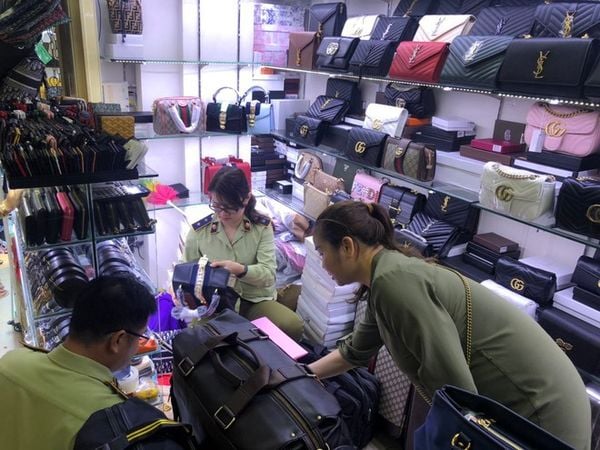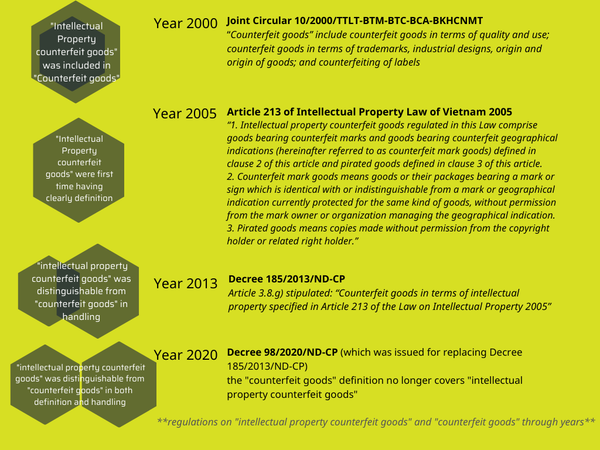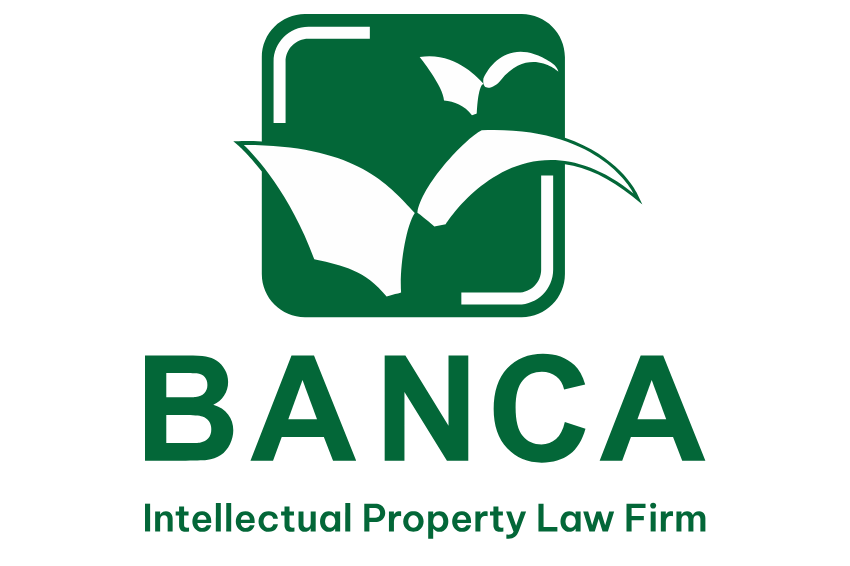WHAT ARE “INTELLECTUAL PROPERTY COUNTERFEIT GOODS”?
“Intellectual Property counterfeit goods” are defined by Article 213 of the IP Law 2005 which has been amended and supplemented in 2009. It is said that:
“1. Intellectual property counterfeit goods regulated in this Law comprise goods bearing counterfeit marks and goods bearing counterfeit geographical indications (hereinafter referred to as counterfeit mark goods) defined in clause 2 of this article and pirated goods defined in clause 3 of this article.
2. Counterfeit mark goods means goods or their packages bearing a mark or sign which is identical with or indistinguishable from a mark or geographical indication currently protected for the same kind of goods, without permission from the mark owner or organization managing the geographical indication.
3. Pirated goods means copies made without permission from the copyright holder or related right holder.”

WHAT ARE “COUNTERFEIT GOODS”?
Meanwhile, “Counterfeit goods” are defined by Article 3.7 of Decree 98/2020/NĐ-CP as:
“a) Goods of which are not consistent with their nature or names; goods of which are useless or their using purpose are not correct with which have been announced or registered;
b) Goods of which one of quality indicators or basic specifications or the amount of primary substances contributing to their uses only reaches 70%, or less, compared to the minimum levels prescribed in technical regulations or quality standards registered, or announced, or specified in their labels or packages;
c) Counterfeit drugs defined in Clause 33 Article 2 of the 2016 Law on Pharmacy and counterfeit herbal ingredients defined in Clause 34 Article 2 of the 2016 Law on Pharmacy;
d) Veterinary drug or pesticide that does not contain any active ingredients; does not contain all of registered active ingredients; contains active ingredients other than those specified on its label or package; contains at least an active ingredient whose content only reaches 70%, or less, compared to the minimum level prescribed in relevant technical regulations or quality standards registered or announced;
dd) The good whose label or package containing information forging name or address of manufacturer, importer or distributor, forging registration number, declaration number or barcode of the good, forging package of good of another entity, or forging the origin of good or place of manufacturing, packaging or assembling;
e) Counterfeit stamps, labels and packages of goods.”

“Intellectual property counterfeit goods” was included in the definition of “counterfeit goods” for a long time!
At the present, these two concepts are somewhat clear, but few people know that the process of forming these two concepts has a lot of troubles and overlaps for a long time. This led to confusion for enforcement bodies and judicial authorities in handling cases related to “intellectual property counterfeit goods” and “counterfeit goods”.

It was not until 2000, that the definition of “counterfeit goods” was defined in Vietnam regulations. “Counterfeit goods” include counterfeit goods in terms of quality and use; counterfeit goods in terms of trademarks, industrial designs, origin and origin of goods; and counterfeiting of labels. This regulation was indicated in the Joint Circular No. 10/2000/TTLT-BTM-BTC-BCA-BKHCNMT dated April 27, 2000. With this concept, “intellectual property counterfeit goods” was included in the concept of “counterfeit goods”. This has led to the result that for many years, cases related to “intellectual property counterfeit goods” were treated the same as cases related to “counterfeit goods”.
In 2005, the Law on Intellectual Property was first promulgated, the definition of “intellectual property counterfeit trademark goods” had a clear concept for the first time indicated in Article 213 as mentioned above.
In 2013, Decree 185/2013/ND-CP on regulations on sanctioning of administrative violations in commercial activities, production and trading of counterfeit goods, banned goods and protection of consumers’ interests was promulgated. Article 3.8.g) stipulated that “Counterfeit goods in terms of intellectual property specified in Article 213 of the Law on Intellectual Property 2005”. As a result, the law has made a distinction, although very small and difficult to recognize, between the two concepts of “counterfeit goods” and “intellectual property counterfeit goods”.
More specifically, “intellectual property counterfeit trademark goods” were “classified” with other types of “counterfeit goods” conceptually, but they had been differentiated when handling. In details, “intellectual property counterfeit goods” would be handled in accordance with Decree 99/2013/ND-CP on sanctioning of administrative violations in the field of industrial property, instead of handling under Decree 185/2013/ND-CP like other counterfeit goods (see: Article 1.3 of Decree 185 stipulates: administrative violations in commercial activities in terms of … intellectual property… then the provisions of administrative sanctions shall be applied in the fields of state management).
However, as of 2013, “intellectual property counterfeit mark goods” were still within the scope of the concept of “counterfeit goods”. This led to a lot of inadequacies in handling cases related to “counterfeit goods” and “intellectual property counterfeit goods”. Faced with that situation, the Ministry of Justice issued Document No. 3250/BTP-PLHSHC dated August 26, 2019 to the Prime Minister, proposing the Government to “amend and supplement relevant legal documents to ensure that there is a clear distinction between the concept of counterfeit goods and intellectual property counterfeit goods, as the basis for the determination of crimes”. The proposal of the Ministry of Justice was approved by the Prime Minister by Document No. 8172/VPCP-V.I dated September 11, 2019.
Immediately after that, for the first time in Vietnam’s judicial history, the definitions of “counterfeit goods” and “counterfeit trademark goods” were clearly delineated by Decree 98/2020/ND-CP (which was issued for replacing Decree 185/2013/ND-CP). Specifically, the definition of “counterfeit goods” no longer contained the object of “intellectual property counterfeit goods”.
Decree 98 took effect from October 15, 2020, so from that time, enforcement bodies and judical authorities have full legal provisions from concepts to methods to handle “counterfeit goods” and “counterfeit intellectual property goods”.
If you need any helps, please feel free to contact us. We will get back to you with 1 business day. Or if in hurry, just call us now.
Call : +84 93 893 1313
mailbox@bancavip.com Mon – Fri 08:30-18:00 (GTM+7)
